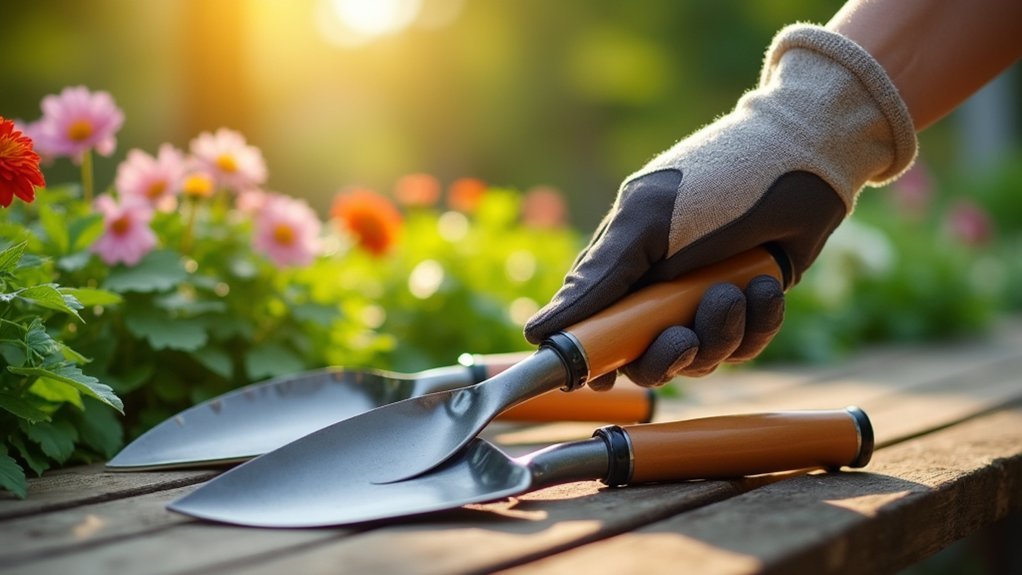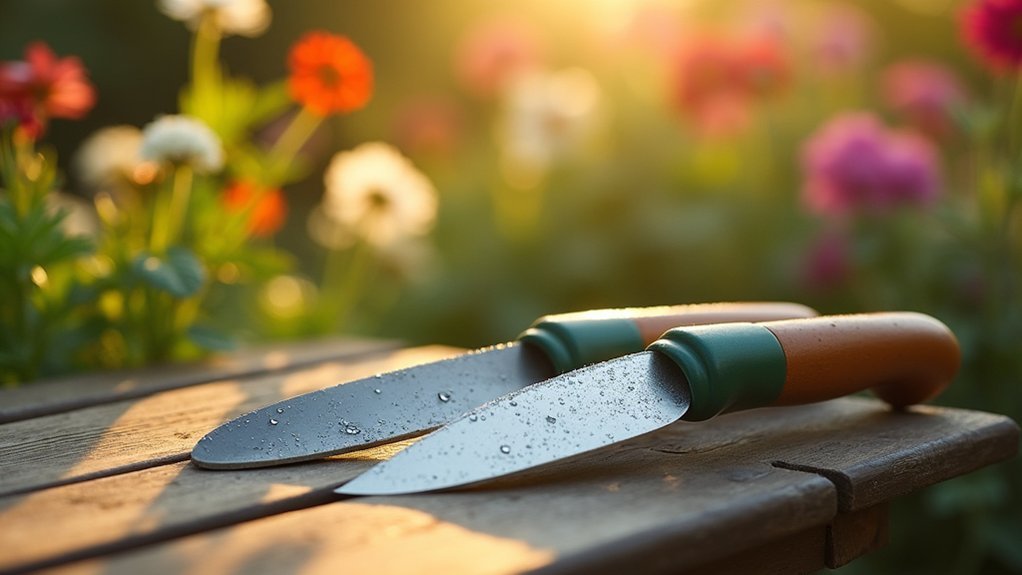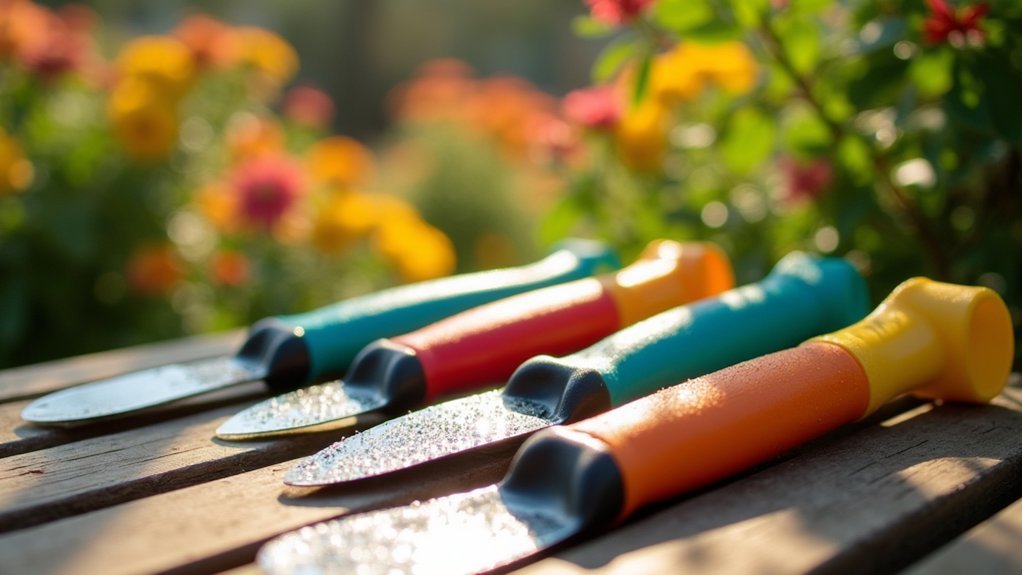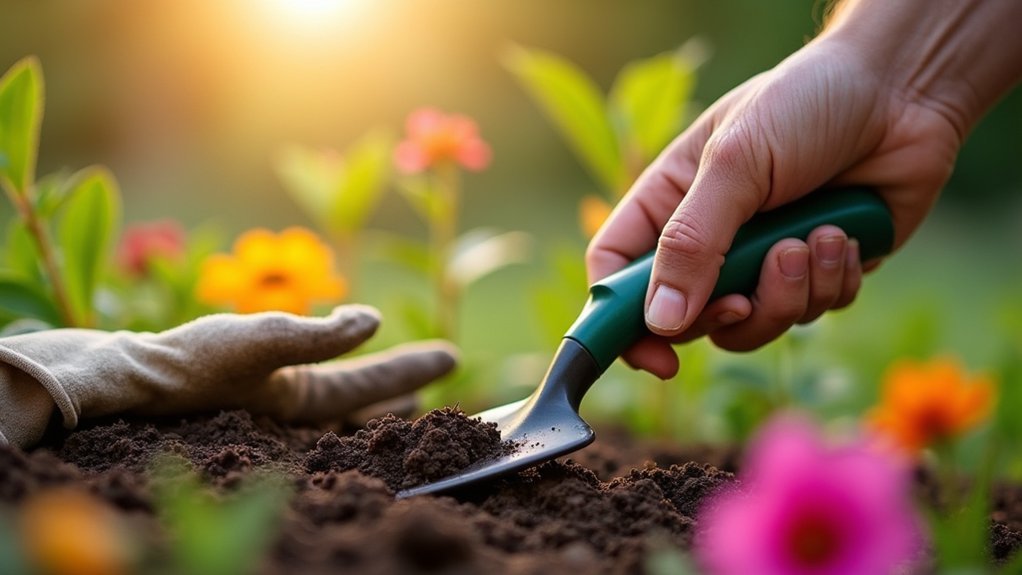Ergonomic gardening tools can transform your experience if you have arthritis by reducing joint strain and pain. They feature specially designed handles that distribute force evenly, keeping your wrists in neutral positions. With lightweight materials, padded grips, and better leverage, you’ll garden longer with less discomfort. These tools minimize repetitive movements and awkward angles that trigger inflammation. The right ergonomic equipment doesn’t just protect your joints—it helps reclaim the joy and therapeutic benefits of gardening.
Relieving Joint Stress Through Better Tool Design

When arthritis makes gardening painful, ergonomic tools can transform the experience from agonizing to enjoyable. These specially designed tools reduce strain on your joints by featuring handles that fit comfortably in your hand and distribute force more evenly across wrists and fingers.
You’ll find that ergonomic tools help you avoid the repetitive movements that typically worsen joint pain. Products like Peta Easi-Grip tools provide longer reach and easier gripping, eliminating the need to bend or strain while working. Using tools with Arthritis Foundation recognition, like Fiskars pruners and loppers that deliver two-to-three times more cutting power, makes gardening tasks significantly easier.
The thoughtful design minimizes pressure on small joints—crucial when you’re dealing with arthritis inflammation.
Comfort Features That Reduce Fatigue While Gardening
Gardening with arthritis demands tools that not only reduce joint strain but also prevent fatigue during extended sessions. Look for lightweight materials like aluminum or plastic that minimize arm strain while maintaining durability. The ideal handle diameter of approximately 33mm (1.3 inches) offers best grip comfort for most gardeners. Products like the Peta Easi-Grip garden tools are specifically designed for arthritis sufferers who might otherwise give up their gardening hobby.
| Feature | Benefit |
|---|---|
| Contoured handles | Reduces wrist strain and improves natural grip position |
| Padded grips | Absorbs pressure points and decreases hand fatigue |
| Textured surfaces | Prevents slipping and reduces gripping force needed |
You’ll find vibration-dampening features particularly helpful when using power tools, as they protect sensitive joints from jarring movements. When paired with non-slip handles, these elements work together to keep your gardening experience comfortable even during longer sessions.
Protecting Joints From Further Damage and Injury

Your gardening tools should provide proper leverage to minimize strain on fragile joints while performing tasks like digging or pruning.
Ergonomic designs greatly reduce motion stress by keeping your wrists and hands in neutral positions rather than forcing awkward angles that aggravate arthritis.
Shock-absorbing features like padded grips and cushioned handles protect your joints from harmful vibrations and impacts that could lead to further inflammation or damage.
Vertical handle trowels are particularly beneficial as they maintain a neutral wrist position and prevent the knuckle compression common with traditional gardening tools.
Proper Tool Leverage
The three key principles of proper tool leverage can dramatically reduce joint stress for arthritis sufferers. Ergonomically designed tools distribute force evenly across your hand and arm, preventing localized pressure on vulnerable joints. Tools with extended handles enhance leverage while minimizing the need to bend, protecting your joints from overextension. Individuals with joint problems benefit significantly from the padded tools available in today’s market.
| Leverage Feature | Benefit | Example Tool |
|---|---|---|
| Extended Handles | Reduces bending | Peta Easi-Grip Long Reach Set |
| Padded Grips | Absorbs shock | Compression Garden Gloves |
| Contoured Design | Aligns with hand | Pro Ergonomic Lite Shovel |
Look for tools like the 4-Claw Weeder that eliminate kneeling or bending, which can trigger joint pain. Padded handles provide vital shock absorption, reducing the grip pressure needed and lowering strain on your hands and wrists.
Motion Stress Reduction
When arthritis affects your hands and joints, motion stress reduction becomes essential to prevent further damage while gardening. Ergonomic tools minimize repetitive strain by requiring less effort for digging, pruning, and planting while promoting natural wrist and arm positions.
These specialized tools facilitate smoother movements that protect small hand and wrist joints from overuse injuries. They’re designed to distribute force evenly across your hands, preventing peak pressures that can trigger inflammation in arthritic joints. Proper ergonomic designs like the Pruner with Rotating Handle allow for natural finger movement along the grips while reducing wrist strain during cutting tasks.
By encouraging an open, relaxed grip, they reduce the need for forceful gripping that often aggravates finger joints. You’ll also benefit from improved stability that prevents sudden jerky movements and eliminates compensatory motions that strain surrounding tissues.
This stability allows you to garden longer without joint overexertion, supporting long-term joint protection.
Shock-Absorbing Design
Shock-absorbing features represent the cornerstone of joint-friendly gardening tools designed specifically for arthritis sufferers.
These specialized tools incorporate vibration-dampening materials that protect your arthritic joints from harmful impacts during cutting, digging, and pruning activities.
When you garden with shock-absorbing tools, you’ll experience:
- Noticeably reduced pain as bumpers and cushioning elements absorb vibrations that typically trigger arthritis flare-ups.
- Enhanced protection against secondary injuries like tendonitis or carpal tunnel syndrome by minimizing stress transmission to vulnerable joints.
- Extended gardening sessions with less fatigue, allowing you to maintain your hobby without sacrificing comfort.
Forged steel construction paired with ergonomic, padded handles distributes force evenly across your hand, preventing concentrated pressure on sensitive joints while still providing the durability needed for effective gardening. Products like the Fiskars SoftGrip Pruner offer lightweight, comfortable handles specifically designed to reduce strain when performing routine garden maintenance.
Enhancing Gardening Efficiency and Productivity

You’ll accomplish gardening tasks in considerably less time with ergonomic tools that maximize leverage while minimizing the strain on your painful joints.
These specialized implements allow you to maintain precision during delicate tasks like pruning or transplanting seedlings, even when your hands aren’t at their best. Cutting and pruning tools with ergonomic grips help maintain wrist and hand neutrality during extended gardening sessions.
With proper ergonomic equipment, you can work more efficiently through your garden chores without the interruptions that pain typically forces.
Faster With Less Pain
Gardening enthusiasts with arthritis can greatly improve their efficiency and comfort through specialized ergonomic tools.
You’ll complete tasks with less strain on your joints while maintaining your independence in the garden.
With the right equipment, you’ll experience:
- Considerably reduced physical effort – long-handled tools minimize bending and kneeling, keeping your body in natural positions that won’t aggravate arthritis pain.
- Increased speed and productivity – electric weeders and power tools automate strenuous tasks, allowing you to accomplish more in less time.
- Greater stamina and enjoyment – padded grips and ergonomic designs require less grip strength, preventing fatigue so you can garden longer without pain.
These improvements mean you’ll spend more time enjoying your garden and less time recovering from its maintenance. Drip irrigation systems also eliminate the need to carry heavy watering cans, making garden maintenance more accessible and enjoyable.
Precision Without Strain
While traditional gardening tools require significant force and awkward positioning, ergonomic alternatives offer remarkable precision with minimal joint stress. The neutral hand position and balanced weight distribution let you work with greater dexterity and control, making delicate tasks easier on your joints.
| Tool Feature | Benefit for Arthritis |
|---|---|
| Angled handles | Reduce wrist strain and maintain neutral position |
| Extended reach | Minimize bending and kneeling, preserving hip and knee joints |
| Comfort grips | Decrease pressure points and distribute force evenly |
You’ll notice improved accuracy in planting, pruning, and weeding without the fatigue that typically accompanies these tasks. With ergonomic tools, you can work longer with greater precision, maintaining garden aesthetics without sacrificing your comfort or independence. The thoughtful design transforms gardening from a painful chore into an enjoyable activity you can sustain.
Mental Health Benefits of Pain-Free Gardening
Beyond the physical advantages of using ergonomic tools, the mental health benefits of pain-free gardening can be transformative for those with arthritis. When you’re able to garden without pain, you tap into nature’s therapeutic power while engaging in meaningful activity that boosts your mental wellbeing.
Ergonomic gardening delivers these psychological benefits:
- Stress reduction – The combination of outdoor exposure, repetitive tasks, and reduced cortisol levels creates a natural anti-anxiety effect, particularly valuable when pain isn’t dominating your experience. Gardening routines provide soothing rhythm that can significantly lower anxiety levels.
- Mindfulness practice – Pain-free gardening allows you to focus fully on sensory experiences—soil texture, plant aromas, and vibrant colors—rather than discomfort.
- Emotional resilience – Overcoming gardening challenges builds mental toughness and coping skills that transfer to managing arthritis in daily life.
Finding the Right Ergonomic Tools for Your Specific Needs

Selecting the right ergonomic tools for arthritis requires careful consideration of your specific joint limitations and gardening needs. Match each tool to its intended task—lightweight trowels with large grips for planting, cultivators for shallow soil work, and pruners with lever arms for cutting tasks.
For grip-sensitive hands, look for padded handles and rubberized grips that provide comfort while maintaining control. If bending is difficult, invest in long-reach handles and garden kneelers that offer stability at ground level.
Consider tools with arm support cuffs to distribute weight evenly and reduce wrist strain. Don’t overlook customization options—adjustable handles accommodate different hand sizes, while personalized grip sizes can greatly reduce fatigue during extended gardening sessions. Choose tools that allow your arms and legs to work together for maximum leverage and efficiency.
The right tools will keep your wrists in a neutral position, minimizing joint stress.
Frequently Asked Questions
How Much More Do Ergonomic Gardening Tools Typically Cost?
You’ll typically pay 20-50% more for ergonomic gardening tools compared to standard versions. A basic ergonomic trowel costs $15-$40 versus $10-$25 for regular ones, while specialized options with enhanced features can exceed $60.
Can Ergonomic Tools Be Modified for Changing Arthritis Symptoms?
Yes, you can modify ergonomic tools as your arthritis changes. Look for interchangeable grips, adjustable handles, and modular systems that adapt to joint mobility shifts, swelling, and pain levels over time.
Are Prescription Ergonomic Gardening Tools Covered by Insurance?
Prescription ergonomic gardening tools aren’t typically covered by standard insurance policies. You’ll need to check with your provider about medical equipment coverage, as you might need a doctor’s documentation proving medical necessity for reimbursement.
How Often Should Ergonomic Tools Be Replaced?
You should replace ergonomic tools when you notice wear on grips, reduced comfort, or decreased functionality. There’s no fixed timeline, but regular inspection and proper maintenance will extend their lifespan considerably.
Can Children With Juvenile Arthritis Benefit From Ergonomic Gardening Tools?
Yes, your child with juvenile arthritis can definitely benefit from ergonomic gardening tools. They’ll experience less pain and fatigue while enjoying gardening, thanks to the lightweight designs and easier grips these tools provide.
In Summary
Don’t let arthritis rob you of gardening joy. By investing in ergonomic tools, you’re protecting your joints, reducing pain, and extending your gardening career. These specially designed implements work with your body rather than against it, allowing you to tend your garden efficiently and comfortably. Make the switch today—your hands, wrists, and overall wellbeing will thank you for years to come.





Leave a Reply